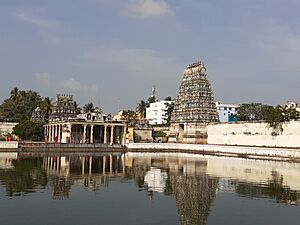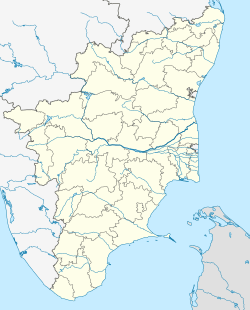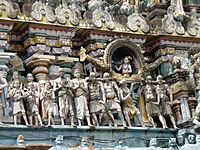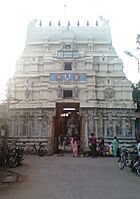Sirkazhi facts for kids
Quick facts for kids
Sirkazhi
|
|
|---|---|
|
Town
|
|

A view of temple tower of Sattainathar Temple located in the centre of the town
|
|
| Country | |
| State | Tamil Nadu |
| Region | Chola Nadu |
| District | Mayiladuthurai |
| Area | |
| • Total | 13.21 km2 (5.10 sq mi) |
| Elevation | 4 m (13 ft) |
| Population | |
| • Total | 34,927 |
| • Density | 2,644.0/km2 (6,847.9/sq mi) |
| Languages | |
| • Official | Tamil |
| Time zone | UTC+5:30 (IST) |
| PIN |
609110
|
| Telephone code | (91) 4364 |
| Vehicle registration | TN-82-Z |
| Nearest town | Mayiladuthurai, Chidambaram |
Sirkazhi (also spelled Sirkali or Siyali) is a town in the Mayiladuthurai district of Tamil Nadu, India. It's about 13 kilometers (8 miles) from the Bay of Bengal coast. The state capital, Chennai, is about 250 kilometers (155 miles) away.
Sirkazhi used to be part of the Thanjavur district until 1991. Then it became part of the Nagapattinam district. Now, it's in the newly formed Mayiladuthurai district. The town covers an area of 13.21 square kilometers (5.10 sq mi). In 2011, its population was 34,927 people. A local government body called a "second grade municipality" manages the town. Sirkazhi is in the Cauvery Delta region, where farming is the main job. Roads are the main way to travel, including a national highway.
This town is very old. Many powerful groups have ruled it, including the Medieval Cholas, Later Cholas, Later Pandyas, the Vijayanagar Empire, the Marathas, and the British. Sirkazhi is famous as the home of three important Carnatic music composers: Arunachala Kavirayar, Muthu Thandavar, and Marimutthu Pillai. A famous saint named Tirugnanasambandar was born here in the 7th century. The town's history is closely linked to the Sattainathar Temple, which is dedicated to the Hindu god Shiva. Another important temple is the Rajarajeshwari – Angalaparameshwari Temple, dedicated to the goddess Adi Shakti. People believe the town's name "Sirkali" comes from the goddess's powerful form, "Shri Kali."
Contents
Names and Legends of Sirkazhi
In olden times, Sirkazhi had many different names. Some of these were Brahmapuram, Venupuram, Thonipuram, and Kazhumalam.
According to Hindu stories, there was once a huge flood that covered the entire Earth. The Hindu god Shiva is said to have carried 64 different arts on a raft, which is called Thoni in Tamil. Because of this, Shiva in the local temple is called "Thoniappar" (meaning "the one who carried the raft"). The area itself was then called "Thonipuram."
Another story says that the Hindu god Brahma worshipped Shiva here. This gave Shiva the name "Bhrahmapureeswarar" (meaning "the one worshipped by Brahma"). So, the area was also known as "Brahmapureeswaram."
Shiva is also believed to have shown his power over the three worlds here. This made him known as "Sattainathar." That's why a part of modern Sirkazhi is called "Sattainathapuram."
During the early Chola period, the town was known as "Kalumalam." A famous saint named Thirugnanasambandar was born here in the 7th century. When he was a baby, the divine mother Parvati is believed to have fed him the milk of wisdom by the temple tank. After that, baby Sambandar started singing holy songs. He called the town "Kazhi" in his songs. During British rule, the town was called Shiyali. After India became independent, it was renamed "Sirkazhi."
History of Sirkazhi
The first time Sirkazhi is mentioned in history is in the stories of the Chola king Kocengannan. He lived during the Sangam Age (from 3rd century BCE to 4th century CE). People believe he won a big battle here.
In the 7th and 8th centuries, there were many disagreements between two Hindu groups: Saivism (who worship Shiva) and Vaishnavism (who worship Vishnu). Two important saints, Tirugnanasambandar (Saivism) and Thirumangai Alvar (Vaishnavism), both from Sirkazhi, had debates about their religious ideas.
The Chola Kings ruled this area for over 400 years, from 850 to 1280. They were big supporters of the temples. There are 41 old writings from the Chola kings in the temple. These writings talk about gifts they gave to the temple, like land, sheep, cows, and oil.
In 1532, the Pandyas took control of the region. Later, it became part of the Thanjavur Nayak kingdom. In 1674, Ekoji I conquered the area. He was a Maratha ruler and half-brother of Shivaji.
By the mid-18th century, the town became part of the British East India Company. In 1799, the Tanjore district was formed. This happened when the Maratha ruler Serfoji II gave most of his kingdom to the British. After India became independent, Sirkazhi remained part of Thanjavur district until 1991. Then it moved to Nagapattinam district until March 2020. Today, Sirkazhi is part of the new Mayiladuthurai district.
Geography and Nature
Sirkazhi is located at 11.23° N latitude and 79.73° E longitude. It's on the eastern side of a ridge that runs along the Kollidam River. The town is about 5.18 meters (17 feet) above sea level. It's also about 13 kilometers (8 miles) west of the Bay of Bengal. Sirkazhi is 95 kilometers (59 miles) northeast of Thanjavur, 24 kilometers (15 miles) north of Mayiladuthurai, and 20 kilometers (12 miles) south of Chidambaram.
The town has long summers and short winters. It gets about 1250 millimeters (49 inches) of rain each year, mostly from the northeast monsoon between October and December. Because it's close to the sea, Sirkazhi gets more rain than nearby towns.
Sirkazhi is part of the Cauvery delta region. It has irrigation channels called Kollidam channels. These channels bring water from rivers, leaving behind rich, fertile soil before flowing into the sea. The soil is black and very good for farming. The main crop grown here is rice. Other crops include coconut, tamarind, and neem. The land is mostly flat fields with some small areas of wild bushes. You might find animals like Antelope, spotted deer, wild hog, jackal, and fox in the wilder areas. Crows and other common birds are also found in large numbers.
In 2004, a huge tsunami hit the Indian Ocean. It was caused by a powerful earthquake near Sumatra, Indonesia. Nagapattinam district was the worst hit part of Tamil Nadu. Sirkazhi was mostly safe from the tsunami. However, the quality of the underground water changed. Saltwater from the sea entered the freshwater sources in some places.
People and Population
| Religious census | ||||
|---|---|---|---|---|
| Religion | Percent(%) | |||
| Hindu | 86.91% | |||
| Muslim | 9.46% | |||
| Christian | 2.16% | |||
| Sikh | 0.02% | |||
| Buddhist | 0.46% | |||
| Jain | 0.33% | |||
| Other | 0.63% | |||
| No religion | 0.04% | |||
| Historical population | ||
|---|---|---|
| Year | Pop. | ±% |
| 1961 | 19,531 | — |
| 1971 | 22,711 | +16.3% |
| 1981 | 25,508 | +12.3% |
| 1991 | 28,959 | +13.5% |
| 2001 | 32,228 | +11.3% |
| 2011 | 34,927 | +8.4% |
Sources:
|
||
According to the 2011 census, Sirkazhi had a population of 34,927 people. For every 1,000 males, there were 1,028 females. This is higher than the national average of 929 females per 1,000 males.
About 3,367 children were under the age of six. Of these, 1,740 were boys and 1,627 were girls. People from Scheduled Castes and Scheduled Tribes made up about 23.21% and 0.13% of the population, respectively. The average literacy rate (people who can read and write) in the town was 81.5%. This is higher than India's national average of 72.99%.
The town had 8,756 households. There were 11,476 workers in total. Most people worked in other jobs (7,681), while some were agricultural laborers (1,398) or cultivators (352).
In terms of religion in 2011, most people in Sirkazhi were Hindus (86.91%). There were also Muslims (9.46%), Christians (2.16%), and smaller numbers of Sikhs, Buddhists, and Jains.
In 1981, there were 15 recognized slum areas where 4,499 people lived. By 2001, these same 15 slums had 7,533 people. The size of the slum areas has stayed the same. The town has different areas for homes, shops, industries, and public spaces.
Economy and Transportation
Most jobs in Sirkazhi are in the service sector, like working in shops or providing services. Some farming is done, and the main crop is paddy rice. In the past, during British rule, Sirkazhi was known for making mats from a special type of grass.
Many government offices are located in the town. There are no large factories in Sirkazhi, but there are several rice mills. Sirkazhi has many Hindu temples, which bring in tourists. The Sirkali Coop Urban Bank, founded in 1918, is the oldest bank here. All major national and private banks have branches and ATMs in the town.
The National Highway NH-32 goes through Sirkazhi. This highway connects Chennai and Thoothukudi. Sirkazhi also has a bypass road to help heavy vehicles travel easily around the town. The Sirkazhi municipality manages 51.5 kilometers (32 miles) of roads.
In the 1950s, people often used Bullock carts to travel. Today, buses are the main way people get around. The town has a bus stand with 36 bays for local and intercity buses. Buses run by the Tamil Nadu State Transport Corporation connect Sirkazhi to other cities like Mayiladuthurai, Kumbakonam, and Chennai.
The Sirkazhi railway station is on the main train line between Chennai and Trichy. Daily express trains connect Sirkazhi to major cities in Tamil Nadu. Weekly express trains also go to places like Tirupathi and Varanasi. There are also daily local trains. The closest airport is Tiruchirapalli Airport, which is about 160 kilometers (99 miles) from Sirkazhi.
Education and Services
The first English school in Sirkazhi was the Leipzig Evangelical Lutheran Mission School, opened in 1896. This mission was started in 1778 to spread Christian knowledge.
Sirkazhi has 32 schools. Nine of these are municipal schools (run by the town). There are three higher secondary schools, three middle schools, fourteen primary schools, and three matriculation schools. For higher education, there are two arts and science colleges: BEST College of Arts and Science and Vivekananda College of Arts and Science. Srinivasa Subbaraya Polytechnic College is located about 7 kilometers (4 miles) from Sirkazhi.
The Tamil Nadu Electricity Board (TNEB) provides electricity to the town. Sirkazhi municipality supplies water from the Kollidam river. This water is stored in five tanks and supplies 2 million liters (about 530,000 gallons) per day.
Workers use push carts and tricycles to collect garbage. This waste is then taken to marsh lands outside the town. Sirkazhi municipality is working on an underground drainage system. Currently, sewage is handled by septic tanks and public toilets. Untreated sewage sometimes flows into roadside drains, which can end up in the sea or low-lying areas.
Sirkazhi is part of the Sirkazhi Telecom Circle of Bharat Sanchar Nigam Limited (BSNL). BSNL is India's government-owned telephone and internet provider. It also offers broadband internet service. The town has one government hospital, 12 private hospitals, clinics, and medical shops.
Culture and Temples
The Bhramapureeswarar temple, also known as Sattainathar temple, is a very old temple dedicated to Shiva. It has three shrines for Shiva. This temple is mentioned in ancient holy writings called Tevaram by important saints like Thirugnana Sambanthar. It is considered a very sacred place.
There is a special shrine for Sambandar here. It celebrates the story of the goddess Parvati feeding milk to baby Sambandar when he was crying. Shiva is worshipped in three different forms in this temple. The original temple was made bigger by several Chola kings between the 11th and 13th centuries. Every year, a 10-day festival is celebrated in the Tamil month of Chithirai (April–May).
The Kazheesirama Vinnagaram temple, also called Thadalan Koil, is dedicated to the god Vishnu. Sirkazhi is also a good base to visit nearby places like Poompuhar and many other temples. There are eleven Vishnu temples nearby, called Nangur Divya Desams. These temples are highly respected in the Nalayira Divya Prabandham holy book. An annual festival called Garudasevai, held in January, attracts thousands of visitors.
Three famous composers of Carnatic music, known as Tamil Isai Moovar, came from Sirkazhi. They are Arunachala Kavirayar, Muthu Thandavar, and Marimutthu Pillai. Arunachala composed religious songs praising Sirkazhi. S. R. Ranganathan, who is considered the father of library science in India, is also from Sirkazhi. Padma Shri Sirkazhi Govindarajan, a well-known singer of Carnatic music and songs for Tamil cinema, was also born here.
See also
 In Spanish: Sirkali para niños
In Spanish: Sirkali para niños





